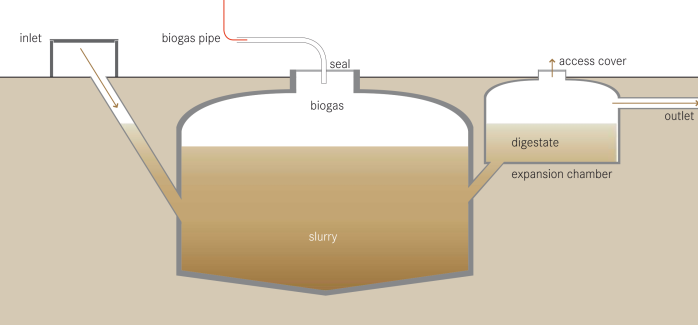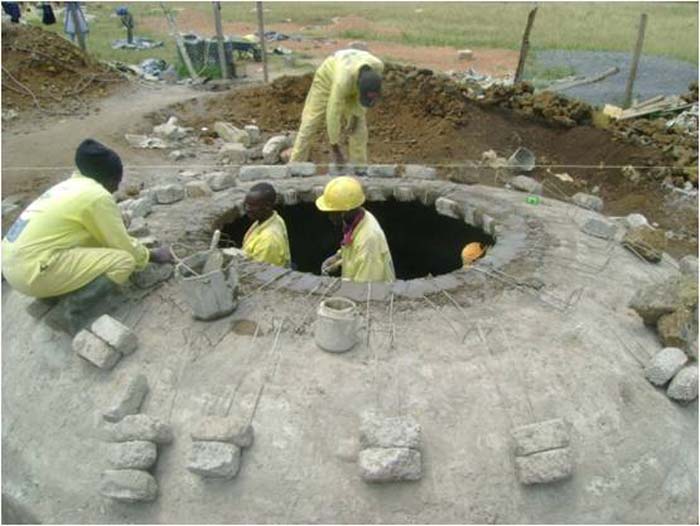
The term “school biogas” usually describes creating biogas, a sustainable energy source, from the anaerobic digestion of organic waste produced on school grounds. In an oxygen-free environment, bacteria break down organic materials such as yard trimmings, paper waste, and food scraps to produce biogas, primarily composed of carbon dioxide and methane.
Through a process known as anaerobic digestion, various organic sources can help generate biogas. It is possible to produce biogas from a variety of organic waste streams in a school environment.
Sources of school biogas
Human Waste
There are situations in which schools might be able to access human waste stored in toilet facilities. It is possible that this is not a prevalent supply in all environments. Nonetheless, there is technology that can properly handle human waste to produce school biogas.
Yard Waste
School grounds can be a source of organic materials for biogas production, such as grass clippings and leaves.
Biodegradable lab waste
Organic waste can also come from scientific labs as a result of various experiments and research projects. Biogas production can make use of this waste.
Paper Waste
Composted paper waste from various school facilities, including offices, classrooms, and others, can produce biogas.
Kitchen oils and grease
School biogas can come from processing used cooking greases and oils in school kitchens.
Food Waste
Leftovers, food waste, and spoiled or otherwise unusable food produce a mountain of food waste at school cafeterias. By collecting this organic waste, schools can use it as a raw material for biogas production.
Animal Waste
If the institution raises animals or offers agricultural programs for educational purposes.
Several phases are usually included in implementing a school biogas project, including:
- Monitoring and Assessment
Monitor the biogas system’s output, its impact on energy cost and use, and waste diversion rates to assess its performance. You can use this data to improve your operations and find areas for improvement.
- Design and Building
Take into account the school’s requirements and budget when designing a school biogas system. Keep in mind aspects like use options, biogas storage, and waste input. Relevant stakeholders and expert builders may be required to build the system.
- Integration into the Curriculum
Use the school biogas system in the classroom. This is possible by including lessons on renewable energy and sustainability in the curriculum.
- Operation and Maintenance
Educate students and the workforce on how to run the school biogas system safely. Additionally, they should be educated on how to feed organic waste into the system and monitor gas production.
- Feasibility Valuation
Conduct a feasibility valuation to evaluate the school’s potential for a biogas system. This should consider regulatory requirements, available space, and waste generation.
How the private sector can help install school biogas
Several avenues exist via which the private sector may make a substantial contribution to the installation of school biogas systems:
Outreach and engagement with the community
Businesses can spread the word about the advantages of biogas technology by involving the communities in and around schools. Community meetings, demonstrations, and outreach programs are all viable options. They can help get people involved and support school biogas initiatives.
Developing technology and providing services
Thanks to private enterprises working in biogas or renewable energy technology, schools can benefit from efficient and affordable biogas systems. Subsequently, institutions of higher learning can purchase these systems from them, with the bonus of setting up and maintenance services.
Support and policy advocacy
Businesses may help introduce biogas technology into schools by lobbying for regulations and policies that promote its use. They can communicate with lawmakers and emphasize the merits of biogas systems. This includes their financial savings and positive impact on the environment.
Collaborative efforts and partnerships
Businesses in the private sector can collaborate with the government, nonprofits, or even public institutions to launch school biogas projects. By combining the public and private sectors, businesses can better use the resources, knowledge, and access to markets that private enterprises offer.
Assessment and monitoring services
Businesses in the private sector can help schools evaluate the effectiveness of biogas systems by providing assessment and monitoring services. This information can help illustrate to stakeholders how beneficial biogas technology is, enhance system performance, and pinpoint improvement areas.
Finance and Investment
Finance or funding options for schools to establish biogas systems might come from private sector institutions like energy companies, investment corporations, and banks. They can help with the upfront expenditures by providing grants, loans, or other forms of financing.
Training and capacity building
Private sector firms can provide biogas technology capacity-building activities and training programs to the school workforce and students. This can encompass teaching materials, seminars, and workshops to guarantee school biogas systems’ correct functioning and maintenance.
Schools can help promote environmental sustainability by partnering with businesses and expanding students’ educational options. They will acquire the funding, resources, and knowledge necessary to install school biogas systems.
 The benefits of installing biogas in schools
The benefits of installing biogas in schools
Implementing school biogas systems has several potential economic, educational, and environmental advantages. The following are a few major benefits:
- Self-reliance and Resilience
Schools can withstand power outages that affect more conventional power grids when they power themselves with renewable energy. School biogas systems can keep critical services running even when the power goes out or there’s an emergency by providing a steady supply of energy.
- The Protection of the Environment
Installing school biogas systems indicates the community’s dedication to sustainability and environmental protection. Promoting circular economy principles, natural resource conservation, and greenhouse gas emissions is a way schools may set a good example for their students and other stakeholders regarding environmental protection.
- Economical
Producing biogas may save schools a lot of money on energy costs for heating and cooking. By finding new uses for organic waste, schools can also cut spending on waste disposal and fertilizer.
- Management of Waste and its Reduction
School animal husbandry programs, gardens, and cafeterias generate organic waste that a biogas system effectively handles. Schools can reduce their environmental impact and methane emissions by reusing organic waste in biogas digesters. Biogas digesters also produce nutrient-rich fertilizers.
- Integration into the curriculum
The interdisciplinary opportunities presented by biogas systems can benefit many different courses of study. By integrating these disciplines into the classroom, students can explore the practical implications of theoretical ideas in economics, environmental science, biology, engineering, and chemistry.
- Community Engagement
Schools that implement biogas initiatives have the potential to become hubs for community involvement and partnership. Fostering partnerships and community support for sustainable initiatives, schools can include NGOs, local businesses, parents, and government agencies in school biogas system planning, implementation, and maintenance.
- Educational Opportunities
The installation of school biogas systems opens up significant educational opportunities for learners. Students can gain practical experience in anaerobic digestion, sustainability, and renewable energy by operating the biogas digester themselves. As a result, more people in the school community will be concerned about the environment and likely adopt sustainable habits.
- Generation of Renewable Energy
Biogas systems produce methane gas from organic waste, including animal manure and food scraps, through anaerobic digestion. This technique can produce a sustainable energy source that can power schools’ electrical, heating, and cooking needs. The use of biogas has the dual benefit of reducing schools’ carbon impact and dependency on fossil fuels.
Installing school biogas systems, which provide economic, educational, and environmental advantages, can help ensure a more sustainable future for the school and the community.
Conclusion
Note that efficient and safe biogas production requires careful management and processing of organic waste. Administrators should also consider waste pickup, storage, and safety when planning school biogas projects.
Installing a school biogas system has multiple benefits, including mitigating environmental impacts, promoting a more sustainable future, and enhancing educational possibilities for students.
